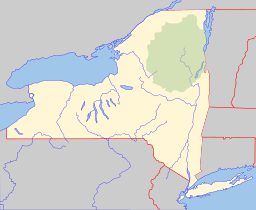Croton Falls Reservoir facts for kids
Quick facts for kids Croton Falls Reservoir |
|
|---|---|
| Location | Putnam County, New York |
| Coordinates | 41°22′19″N 73°40′09″W / 41.3720°N 73.6693°W |
| Type | reservoir |
| Primary inflows | West Branch and Middle Branch of the Croton River |
| Catchment area | 16 sq mi (41 km2) |
| Basin countries | United States |
| Water volume | 14,200,000,000 US gal (0.054 km3) |
The Croton Falls Reservoir is an important artificial lake that helps supply New York City with fresh drinking water. It's located about 50 miles (80 km) north of the city, in Putnam County, New York. This reservoir is a key part of the New York City water supply system.
The reservoir was created by blocking off parts of the West Branch and Middle Branch of the Croton River. These rivers are tributaries of the Croton River, which eventually flows into the Hudson River.
Contents
About the Croton Falls Reservoir
The Croton Falls Reservoir began operating in 1911. It collects water from a large area of 16 square miles (25.6 km²). This area is called its drainage basin. The reservoir can hold a huge amount of water. At full capacity, it can store about 14.2 billion US gallons (53.7 million m³) of water.
Where the Water Comes From
Many smaller bodies of water flow into the reservoir. These include Michaels Brook and Lake Gilead. Lake Gilead is one of three special "controlled lakes" in the Croton Watershed. These lakes are managed to help provide water for the city.
How the Reservoir is Divided
The reservoir is actually split into three main sections. These sections are separated by roads, Putnam County Routes 35 and 38. These roads cross the reservoir using special raised pathways called causeways and bridges.
How Water Travels to New York City
Water from the Croton Falls Reservoir doesn't go straight to New York City. It takes a journey through several other reservoirs first.
The Journey South
First, the water flows into Westchester County, New York. There, it passes through the Muscoot Reservoir and then the New Croton Reservoir. After that, the water enters a large underground tunnel called the New Croton Aqueduct.
Reaching the City
The Aqueduct carries the water through The Bronx, one of New York City's boroughs. It then reaches the Jerome Park Reservoir. From there, the water continues into Manhattan. It even connects with another major water tunnel, the Catskill Aqueduct. Finally, the water travels through the rest of Manhattan and into Brooklyn. Its journey ends in Staten Island, another borough of New York City.
Keeping the Reservoir Safe and Modern
It's very important to keep the reservoir in good condition. This ensures it can continue to provide clean water safely.
Important Upgrades
In 2007, a big project began to improve the Croton Falls Reservoir. This project cost about $74 million. It was part of an effort to meet state and federal safety rules for dams. The Diverting Reservoir also received upgrades at this time.
What Was Improved
Many parts of the reservoir were updated. The spillway, which is where extra water flows out, was made wider and deeper. The large dam, made of earth and stone, was resurfaced. A new bridge was built over the improved spillway. Old parts like valves were replaced with new ones. They also installed strong cables to anchor the dam and spillway to the bedrock below. The project even involved making the reservoir 4 feet (1.2 meters) deeper. The channel connecting the Croton Falls Reservoir to the Diverting Reservoir was also checked and cleaned. This important work was planned to finish by January 2010.]



